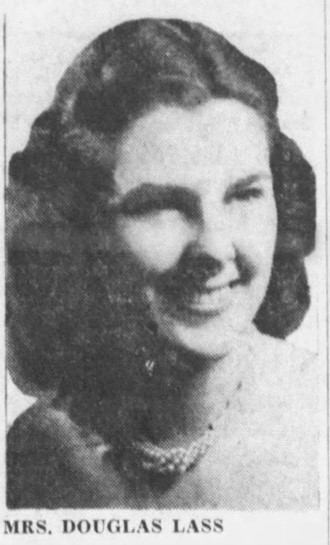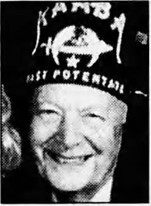
Douglas Harry Lass
1st Lieutenant
100th Infantry Battalion (Separate)
C Company
Douglas Harry Lass was born on March 31, 1918, in Clinton, Iowa. He was the son of Harry Max and Lillian Mildred (Zimmer) Lass. He had a younger sister named Loretta Helen. Harry’s parents had both emigrated to the US from Germany in 1865 and 1893, respectively.

In 1920, Doug, as he was called, lived with his parents at 620 North 5th Street. His father was a car repairman for the railroad. By 1930, they lived at 723 North 3rd Street and Harry was still working for the railroad. Doug graduated from Clinton High School in 1936.
Right: His 1936 Senior Class photo
He played trumpet in the school band and violin in the orchestra. In 1940, the family was still at 723 North 3rd Street and his father was assistant superintendent/manager of an insurance company. Doug was working as an office clerk in a woodworking business.
Douglas H. Lass signed his draft registration card on October 16, 1940, Local Board No. 2, Clinton City Hall. His point of contact was his father, and he was employed as an accountant at Curtiss Companies Inc. at 114 12th Avenue South. He had blue eyes and brown hair, was 5’11” tall, and weighed 153 pounds.
Lass enlisted in the U.S. Army on July 6, 1942. After training, he was assigned to the 100th Infantry Battalion (Separate) as a 2nd Lieutenant.
On September 13, 1943, Lt. Lass arrived at Oran, North Africa, to join the 100th, who had arrived there on September 2. On September 19, the 100th boarded the landing craft U.S.S. Frederick Funston and arrived offshore of Salerno, Italy, at 8:00 a.m. on September 22. The unit entered combat on September 29, near Salerno, as part of the 133rd Infantry, 34th (Red Bull) Division in the Naples-Foggia Campaign.
The 100th fought well as they advanced 15 miles in 24 hours for a week against strong enemy resistance. They suffered casualties, and gained their first major victory by liberating Benevento, an important rail center and road intersection. The 100th had to cross the twisting, muddy Volturno River three times under heavy German machine-gun fire and rocket launchers before driving the enemy farther north. The 100th encountered its most intense fight yet, as they fought from mountain to mountain to Monte Cassino – the key objective to free Rome from the grip of the Nazis.
To defeat the enemy’s Gustav Line, the Allies had to descend into the Rapido River valley, traverse two miles of open fields filled with landmines, mud, and knee-deep cold water, cross a swift-moving river, then climb past more mines and barbed wire and up the steep, rocky slopes to the 1,500’ peak of Monte Cassino. From there they had to ascend still higher to a four-story fortress, with 10’-thick stone walls – the St. Benedictine monastery. The battle commenced in January and a long struggle for the 100th began. It was here that they earned their nickname, the “Purple Heart Battalion.” They incurred so many casualties that their ranks were depleted to the point of not being combat-ready.
On March 26, 1944, the 100th was sent from Monte Cassino to the Anzio beachhead, a wide area held by the Allies around the town of Anzio just south of Rome. Over the preceding months, Lt. Lass had developed trench foot, a very serious foot condition brought on by cold, wet conditions. A week prior to the battalion’s breakout from the beachhead, he was sent to (Oran) North Africa, from where he wrote his parents and sister on May 15 on American Red Cross stationery from the 2628th Hospital Section:
Am now back in a hospital in North Africa. Feeling fine, haven’t been able to walk around as yet but should be before long.
On May 14, he wrote that he was now at Stark General Hospital, Charleston, South Carolina. The next day he also sent them a Western Union telegraph letting them know he had arrived at Stark, was feeling fine, and expecting to be transferred closer to home soon.
My fighting days are over for a while, the feet are getting better little by little but still it will take time to get back in shape. …weigh 140 now. Lost quite a bit as I had yellow jaundice 3 times while in the hospital [in North Africa] but it has cleared up now so gaining again.
On May 24, he wrote again from Ashford General Hospital, White Sulphur Springs, West Virginia, and included a brochure from the Greenbrier Hotel, which had been converted into a military hospital. Lt. Lass wrote on hotel stationery:
Good news. Able to get up and around a little bit now and sure feels good. Hope you get an idea of how nice it is here by the pictures inside. Really enjoying life now. Hope everyone at home is okay.
Lass was unable to walk for about six months and ended up losing parts of his toes. He eventually was transferred to the Army’s Schick General Hospital in his hometown of Clinton to complete the healing process. On February 1, 1945, he reenlisted in the Army and was sent south to train recruits. During a training exercise he was accidentally injured by shrapnel. Lt. Lass was discharged on April 2, 1946.
For his wartime service, 1st Lieutenant Douglas Harry Lass was awarded the Bronze Star Medal, Good Conduct Medal, American Campaign Medal, European-African-Middle Eastern Campaign Medal with one bronze star, World War II Victory Medal, and Combat Infantryman Badge. He was awarded the Congressional Gold Medal on October 5, 2010, along with the other veterans of the 100th/442nd Regimental Combat Team. This is the highest Congressional Civilian Medal.

Lass returned home to Clinton after the war. On November 15, 1947, he married Elaine Marian Sites, the daughter of Mr. and Mrs. John Harvey Sites of Clinton. He worked for Penn Life as an insurance agent and Elaine was a preschool teacher.
Left: Elaine Sites’ wedding photo, 1947
Douglas H. Lass applied to the State of Iowa on May 3, 1949, for compensation from their World War II Service Compensation Fund. His service dates, from entry, to foreign service, to separation, are stated on this application. His domestic service was 45 months, for which he received $450 from the Iowa Fund; his foreign service was eight months and he received $470 for this. He stated that his last unit was C Company, 100th Battalion, 133rd Infantry. The 100th Battalion was attached to the 133rd Infantry Division at that time.

Right: Lass wearing his Shriner’s hat
In 1950, Doug and his wife were living at 816 5th Avenue South in Clinton. He was working as an insurance agent at an insurance and real estate office where Elaine was working as office secretary. He was the owner of this agency, which later merged with the Neubauer and Darr Agency. He was also an appraiser. Over the years, they raised one daughter. Doug was a member and Past Potentate of the Kaaba Shrine Temple of Shriners International, located in Davenport, Iowa.
According to his daughter:
Dad appreciated the men he knew in the 442nd. He felt fortunate to come home after serving overseas, because so many fellow soldiers did not. He had a gentle soul, putting others first and not complaining much. Can imagine his feet were pretty bad before he sought medical attention. In 1970, we visited Hawaii and Dad went to a meeting at the American Legion Post in Honolulu. He was so happy to see some of the men he served with in Italy.
Douglas H. Lass died on January 12, 2003, in Clinton, Iowa. His funeral was held on January 16 at the First United Methodist Church. He was buried with full military honors at Clinton Lawn Cemetery. Survivors included his wife and daughter. His wife Elaine died January 31, 2013, and was buried next to her husband.
Researched and written by the Sons & Daughters of the 442nd Regimental Combat Team with assistance from his daughter in 2022.
